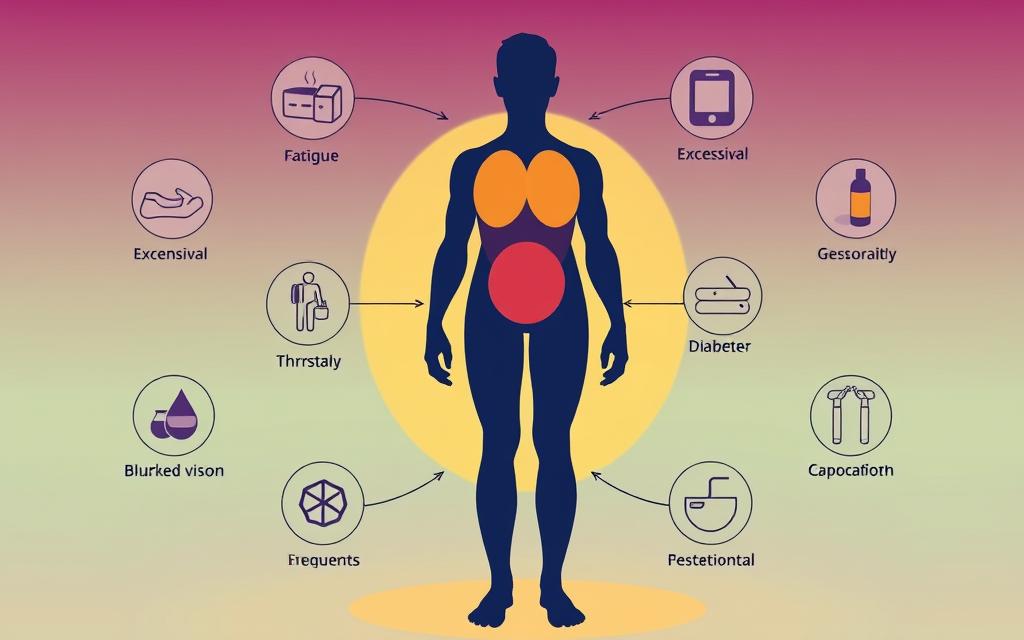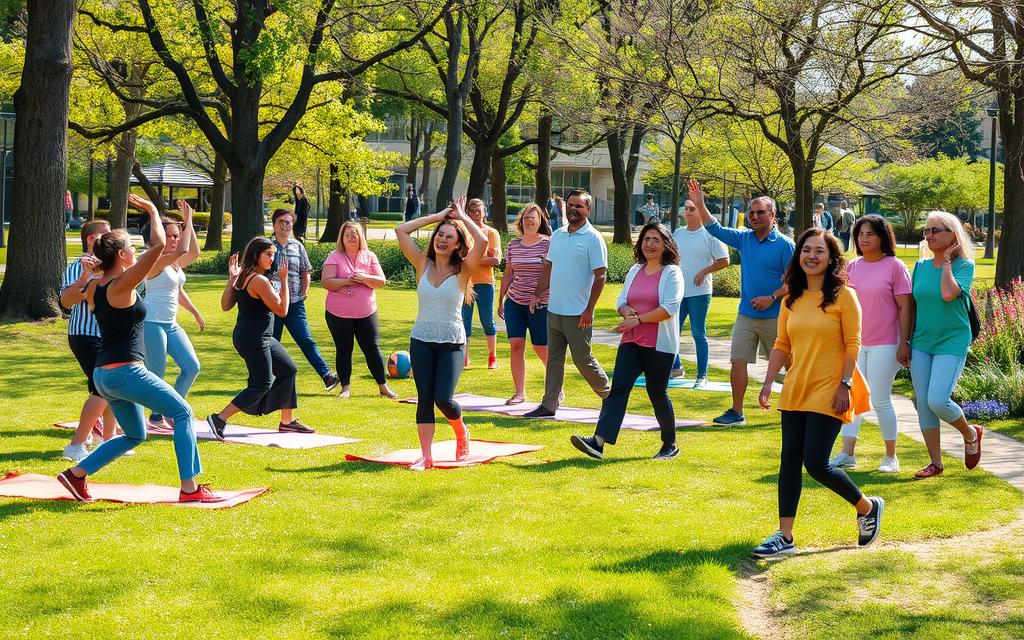Living with diabetes can feel overwhelming and isolating. But, adding exercise to our daily lives can help us manage our condition. It gives us a sense of control over our lives.
Regular physical activity boosts our insulin sensitivity and lowers blood sugar levels. This makes exercise a strong ally in managing diabetes. Every step we take is a step towards better health and well-being.
By choosing an active lifestyle, we can look forward to a brighter future. Diabetes won’t define our lives anymore. It will just be a part of our journey to thrive1.
Key Takeaways
- Regular exercise is vital for lowering blood sugar levels and improving insulin sensitivity.
- The improvement in insulin sensitivity allows better glucose uptake during and after physical activity.
- Monitoring blood glucose before exercise helps prevent hypoglycemia.
- Type 2 diabetes is increasingly common among older adults, making physical activity essential.
- Engaging in regular physical activity can significantly enhance both physical and mental well-being.
- Every step we take can contribute to effective diabetes management and overall health.
The Importance of Exercise in Diabetes Management
Exercise is key in managing diabetes, helping control blood sugar levels. Studies show that regular exercise can lower HbA1c levels, which is good for those with diabetes2. People with diabetes should aim for 150 minutes of moderate exercise each week3. Exercise helps us get better blood glucose readings before and after we do it4.
Exercise is not just good for our bodies but also for our minds. Sticking to a workout routine helps us build healthy habits and feel part of a community. Even small actions, like taking the stairs or walking pets, can boost our activity levels4.
Using apps or wearables to track our progress can motivate us to keep exercising. It’s also important to mix up our activities to avoid getting bored. We should not go more than two days without exercising4.
In short, making exercise a part of our daily lives greatly improves diabetes management. This leads to better health and lowers the risk of diabetes-related problems. With nearly 29.1 million people in the U.S. living with type 2 diabetes2, it’s crucial we understand how exercise can help control this disease.
Understanding Diabetes: Types and Symptoms
Diabetes is a complex condition that affects millions worldwide. It can be divided into three main types: type 1, type 2, and gestational diabetes. Each type has its own set of symptoms and characteristics. Knowing these is key to managing the condition effectively.
Type 1 Diabetes
Type 1 diabetes is an autoimmune condition where the body can’t make insulin. It’s often diagnosed in children and young adults, before they turn 30. As of 2023, about 422 million people worldwide live with diabetes, with type 1 being a smaller but important part5.
Type 2 Diabetes
Type 2 diabetes is caused by insulin resistance and is more common in adults over 40. But, it’s also seen in younger people. In the U.S., over 37.3 million people, or about 11.3% of the population, had diabetes in 20196. About 90% to 95% of diabetes cases are type 26.
Gestational Diabetes
Gestational diabetes happens during pregnancy and can be risky for both mom and baby. It affects 2% to 10% of pregnancies in the U.S5.. Women with gestational diabetes are at a higher risk of getting type 2 diabetes later. It’s important to understand this type for good care before and after birth.

How Exercise Lowers Blood Sugar Levels
Physical activity is key in managing diabetes by lowering blood sugar levels. Doing moderate exercise helps muscles use more glucose, reducing blood sugar7. Regular exercise also boosts insulin sensitivity, helping muscles absorb glucose better8.
Adults with diabetes should aim for 150 minutes of aerobic activity weekly. Children and teens need at least 60 minutes daily9. Strength training 2 to 3 times a week also helps manage blood sugar levels9.
It’s important to know how exercise affects blood sugar before starting. If blood sugar is below 90 mg/dL, a small snack is needed. Levels between 90-124 mg/dL require about 10 grams of glucose for safety9. Exercise can impact blood sugar levels for 4 to 8 hours after, so constant monitoring is crucial8.
Regular physical activity greatly improves diabetes management over time. It leads to better A1C scores, helping us control diabetes9
Exercise Recommendations for Diabetes Management
To manage diabetes well, we need to do different kinds of exercises. We should mix aerobic and strength training. The American Diabetes Association says we should exercise for at least 150 minutes a week at a moderate level. This helps control blood sugar and lowers the risk of health problems from not moving enough10.
By changing up our workouts, we stay interested and get more benefits.
Types of Exercise
There are many exercises we can do, each with its own benefits:
- Aerobic Exercises: Walking, running, cycling, and swimming improve heart health and help with weight control.
- Strength Training: Using weights or bands makes muscles stronger, which can improve how well insulin works.
- Flexibility and Balance Exercises: Yoga and Pilates keep us mobile and prevent falls, which is important for older people.
Duration and Intensity
How long and how hard we exercise is key to managing diabetes. We should aim for 150 minutes of moderate exercise each week, spread over five days. Starting with short sessions, like 10 minutes, helps us keep up with exercise over time11.
Research shows that short, frequent workouts can be as good as longer ones. For example, three 10-minute workouts a day can be as effective as one 30-minute workout10.
It’s important not to take long breaks from exercise. Not moving for more than 48 hours can make it harder to control blood sugar10. Also, knowing how exercise affects our diabetes meds is crucial. Working out two to three hours after eating might mean we need to adjust our insulin to avoid low blood sugar after exercising12.
| Exercise Type | Recommended Duration | Intensity Level |
|---|---|---|
| Aerobic Activities | At least 150 minutes/week | Moderate |
| Strength Training | 2-3 times/week | Varied |
| Flexibility Exercises | As needed | Low to Moderate |
By mixing different exercises, we can improve our health and manage diabetes better.
Getting Started: Safe Exercise Practices
Starting an exercise routine can greatly improve our health, even if we have diabetes. It’s important to begin carefully, focusing on safe practices. A doctor consultation is key to check if we’re ready and to create a plan that fits our health needs. This helps us know our limits and start exercising effectively.
Consulting with Your Doctor
Before starting any exercise, talking to our doctor is crucial. This doctor consultation lets us get advice that’s just right for us, considering our diabetes. Exercise can help control blood sugar and blood pressure, but personalized advice is vital to stay safe. Talking to our doctor helps us figure out the best exercises, how often, and for how long.
Setting Realistic Goals
Setting realistic goals is key to success in exercising regularly. Starting slow helps us feel accomplished and keeps us going. We might start with walking for 30 to 45 minutes, five days a week. As we get better, we can try different exercises like stretching and strength training.
Having clear goals helps us stay motivated and committed. This makes it easier to add exercise to our daily life.
Monitoring Blood Sugar Levels during Exercise
It’s important to know how to check blood sugar levels when we exercise. This helps us see how our bodies react to different activities. For example, running can quickly lower blood sugar, while weightlifting might raise it for people with type 1 diabetes13.
Understanding Blood Glucose Response
To keep blood sugar safe during workouts, we need to know our starting levels. If our sugar is 270 mg/dL or higher, we should avoid hard exercise until it goes down. A level under 100 mg/dL means we need a snack with 15 to 30 grams of carbs to avoid low blood sugar14.
Checking blood sugar often is key, even more so for longer workouts. We should check every 30 minutes if we’re working out for an hour or more.
Preventing Hypoglycemia
It’s crucial to prevent low blood sugar, which is more common for those on insulin. If our levels are below 54 mg/dL in the last 24 hours, we should avoid hard exercise14. Eating a snack 15 to 30 minutes before and every 30 minutes during exercise helps, based on how we react to exercise.
If we get low blood sugar during exercise, we need to eat 10 to 15 grams of fast-acting carbs quickly. After working out, eating slowly absorbed carbs like dried fruit or granola bars helps keep levels stable. People with diabetes might need to cut their insulin dose by 30 percent before or during exercise. But, this should only be done after talking to a doctor13.

The Benefits of Regular Physical Activity
Regular physical activity is key for managing diabetes well. It improves insulin sensitivity, helps with weight management, and boosts heart health. These benefits are crucial for people with diabetes.
Improved Insulin Sensitivity
Exercise makes our cells better at using insulin. This is very helpful for those with type 2 diabetes. Exercise can lower blood sugar for up to 24 hours after, showing why we need to stay active15.
Weight Management
Regular exercise also helps with weight control. Keeping a healthy weight is vital for managing blood sugar and avoiding diabetes complications. The CDC suggests at least 150 minutes of moderate exercise a week for weight loss and better metabolism15.
Enhanced Cardiovascular Health
Exercise is crucial for heart health, which is a big concern for people with diabetes. They are at higher risk for heart disease. Regular exercise can lower this risk. It helps keep the heart healthy and reduces diabetes-related health risks15.
| Benefits of Regular Physical Activity | Details |
|---|---|
| Improved Insulin Sensitivity | Exercise enhances insulin efficacy, aiding in blood sugar management. |
| Weight Management | Aids in maintaining a healthy weight, contributing to lower blood glucose levels. |
| Enhanced Cardiovascular Health | Reduces the risk of heart diseases, crucial for diabetes management. |
By making physical activity a priority, we can manage diabetes better. This improves our overall quality of life16.
Incorporating Exercise into Daily Life
Making exercise a daily habit can be tough. Doing activities we love makes it easier and keeps us going. Enjoyable activities like hiking, swimming, or fitness classes boost our motivation to exercise regularly.
Regular exercise offers many benefits, like better insulin sensitivity and lower blood sugar. These activities are key for our health1718.
Finding Activities You Enjoy
Finding fun activities is key to loving physical activity. We might try different exercises to find what we like. Here are some ideas:
- Group fitness classes
- Outdoor sports
- Dancing
- Cycling with friends
- Yoga or Pilates sessions
By making exercise fun, we stay committed to being active.
Making Exercise a Social Event
Adding social fun to exercise makes it more rewarding. Social exercise builds a support network and keeps us accountable. Joining a running club or sports league can boost our motivation.
The social aspect helps us stay on track. This leads to better health and more fun19.

Enjoyable activities and social exercise help us live a healthy, active life17.
Case Studies: Success Stories of Diabetes Management through Exercise
We often look to diabetes success stories to see how exercise affects our health. T.J., diagnosed with type 1 diabetes at 4 in 2017, has made exercise a big part of his life. This has greatly improved his blood sugar levels and overall lifestyle20. Christine Croteau, diagnosed at 31, shows determination by running a marathon after her diagnosis. Her story shows how setting fitness goals can lead to amazing achievements20.
Danielle Blanchard and Tim Weeden are also inspiring. Danielle has kept her A1c around 6% since being diagnosed at 16 months in 1983. Tim has kept his A1c between 5.8% and 7% for over 35 years20. Their stories show that sticking to an exercise routine can improve health for a long time.
Jim Cormier’s story is also uplifting. He lowered his A1c below 7% with the help of an insulin pump and exercise20. Jason Winters came to a diabetes center with an A1c of 12.3%. After treatment, his A1c dropped below 7%, showing the benefits of a full diabetes management plan that includes exercise20.
Ms. L’s story shows how lifestyle changes can be effective. She was admitted with an HbA1c of 11.1% but improved to 4.9% with exercise and diet changes21. Ms. A also saw her HbA1c drop from 9.9% to 6.0% with similar lifestyle changes21.
These stories show how powerful exercise is in managing diabetes. Regular physical activity not only helps control blood sugar but also improves overall health. This is seen in people of different ages and lifestyles.
Creating a Supportive Environment for Physical Activity
Creating a supportive environment is key for boosting physical activity, even for those with diabetes. A community-focused culture can motivate people by offering support and making them feel responsible. Feeling connected to others and the environment encourages health-promoting activities.
Community Engagement
Community engagement is vital for promoting physical activity. Working with local groups can boost exercise initiatives, like fitness clubs and wellness events. This can help reduce the number of inactive people, as 34.3% of Americans with diabetes don’t meet activity goals22.
By offering social activities, we can encourage more people to reach the 150 minutes of activity weekly goal. Currently, only 23.8% of Americans with diabetes achieve this22.
Access to Facilities
Having easy access to fitness spots is essential for a healthy lifestyle. Gyms, parks, and trails make exercise convenient and fun. Ensuring everyone can access these places helps everyone stay active.
Communities should aim to make physical activities available to all, regardless of income. This approach can greatly improve overall health. By making fitness easy and welcoming, we can reduce the global rate of insufficient physical activity, affecting 27.5% of the world’s population22.

Understanding the Role of a Diabetic Diet in Conjunction with Exercise
A balanced diet is key to managing diabetes, paired with regular exercise. A diabetic diet helps control blood sugar and supports physical activity. Choosing the right foods can boost fitness and keep glucose levels stable.
Balanced Nutritional Choices
Our meals should include whole grains, lean proteins, and healthy fats. Studies show that a structured diet improves insulin use and helps manage weight. This is vital for those with type 2 diabetes.
A well-planned diet can lower HbA1c levels, showing better blood sugar control over time2324. Eating at regular times boosts insulin effectiveness, supporting our exercise goals.
Hydration and Recovery
Hydration is crucial for recovery after exercise. It keeps energy levels up and aids in muscle repair. Drinking enough water is important, as it helps with nutrient transport and muscle recovery23.
Incorporating foods rich in dietary fiber can help with digestion, hydration, and blood sugar control. This contributes to our overall health and wellbeing.
Long-Term Effects of Exercise on Diabetes Management
Regular physical activity greatly improves diabetes management. About 29.1 million people in the United States have diabetes25. Exercise is key to better health. Studies show that active adults see big improvements in their health2.
Exercise also lowers heart disease risks. People with diabetes are 2 to 4 times more likely to get heart disease25. Just 30 minutes of aerobic activity can help control blood sugar2. Resistance training boosts strength and insulin use22.
But, 34.3% of Americans with diabetes don’t exercise enough22. Meeting activity goals can lower diabetes risks and improve control22.
Conclusion
Adding regular exercise to our lives is a strong way to manage diabetes well. It helps improve how our bodies use insulin and keeps our hearts healthy. With nearly 34 million people in the U.S. living with diabetes, it’s clear we need to make exercise and healthy eating a big part of our lives26.
Setting achievable goals and creating supportive spaces helps us take charge of our health. This leads to a healthier life. Also, working with a team of healthcare experts is key to getting the best health results2728. Their teamwork helps us get the care we need, like treatment for eye problems linked to diabetes.
In short, focusing on both exercise and healthy eating is crucial for our well-being. Let’s all work together to improve our health and manage diabetes better. This way, we can live a more fulfilling life and lower the risks of long-term health problems.
FAQ
What types of exercise are best for managing diabetes?
A mix of aerobic exercises like walking and running, and strength training is best. The American Diabetes Association suggests 150 minutes of moderate aerobic activity weekly. Also, do strength training on two or more days.
How does exercise impact blood sugar levels?
Exercise lowers blood sugar by making muscles use glucose better. It also helps muscles take in more glucose, keeping blood sugar stable.
Can I exercise if I have diabetes?
Yes, you can! Exercise is key for managing diabetes and staying healthy. But, talk to your doctor before starting any new workout routine, if you have health issues.
What precautions should I take when exercising with diabetes?
Check your blood sugar before, during, and after working out. Always carry quick carbs with you. Know how your body reacts to different activities. Follow the 15-15 rule if your sugar drops.
How does a balanced diet support diabetes management with exercise?
Eating a balanced diet with whole grains, lean proteins, and healthy fats helps with blood sugar control. Proper nutrition and exercise together improve health and manage diabetes better.
What are some enjoyable ways to integrate physical activity into my daily life?
Choose activities you like, like hiking or swimming. Joining group classes can make exercise more fun. Socializing while exercising boosts motivation and enjoyment.
How can community support help in managing diabetes through exercise?
Being part of a community for exercise can be very supportive. It encourages and holds you accountable. Local gyms, parks, and trails make it easier to stay active.
What are the long-term benefits of regular exercise for individuals with diabetes?
Regular exercise lowers the risk of diabetes complications. It improves insulin sensitivity, helps with weight management, and boosts heart health. These are all key for managing diabetes well.
What should I do if I experience hypoglycemia during exercise?
If you get hypoglycemia, eat fast-acting carbs like glucose tablets or juice right away. Follow the 15-15 rule: eat 15 grams of carbs and check your sugar in 15 minutes.
How can I set realistic exercise goals if I’m new to physical activity?
Begin with small, achievable goals that get more challenging over time. Celebrate your successes. Start with simple activities like taking the stairs or walking.
Source Links
- Understanding Blood Glucose and Exercise – https://diabetes.org/health-wellness/fitness/blood-glucose-and-exercise
- The essential role of exercise in the management of type 2 diabetes – https://pmc.ncbi.nlm.nih.gov/articles/PMC5846677/
- Diabetes and physical activity – https://idf.org/about-diabetes/diabetes-management/physical-activity/
- Get Active – https://www.cdc.gov/diabetes/living-with/physical-activity.html
- Diabetes – Symptoms and causes – https://www.mayoclinic.org/diseases-conditions/diabetes/symptoms-causes/syc-20371444
- What Is Diabetes? – NIDDK – https://www.niddk.nih.gov/health-information/diabetes/overview/what-is-diabetes
- Exercises to Lower Your Blood Sugar – https://www.webmd.com/healthy-aging/features/exercise-lower-blood-sugar
- Does exercise lower blood sugar levels? – https://www.diabetes.org.uk/living-with-diabetes/exercise/blood-sugar-levels
- Diabetes and exercise: When to monitor your blood sugar – https://www.mayoclinic.org/diseases-conditions/diabetes/in-depth/diabetes-and-exercise/art-20045697
- Weekly Exercise Targets | American Diabetes Association – https://diabetes.org/health-wellness/fitness/weekly-exercise-targets
- Exercise and Type 2 Diabetes: The American College of Sports Medicine and the American Diabetes Association: joint position statement – https://pmc.ncbi.nlm.nih.gov/articles/PMC2992225/
- Exercise Guidelines – https://www.uclahealth.org/medical-services/endocrinology/diabetes/type-1-diabetes/exercise-guidelines
- Exercise and Glucose Metabolism in Persons with Diabetes Mellitus: Perspectives on the Role for Continuous Glucose Monitoring – https://pmc.ncbi.nlm.nih.gov/articles/PMC2769951/
- Patient education: Exercise and medical care for people with type 2 diabetes (Beyond the Basics) – https://www.uptodate.com/contents/exercise-and-medical-care-for-people-with-type-2-diabetes-beyond-the-basics/print
- Physical exercise for type 2 diabetes: Benefits and types – https://www.medicalnewstoday.com/articles/type-2-diabetes-physical-exercise
- Exercise & diabetes – Diabetes Australia – https://www.diabetesaustralia.com.au/living-with-diabetes/exercise/
- Benefits of Physical Activity for Managing Diabetes | Banner – https://www.bannerhealth.com/healthcareblog/better-me/how-exercise-can-help-you-manage-diabetes
- Energizing Your Journey: Physical Activity Goals for People with Diabetes – Allison Medical – https://www.allisonmedical.com/physical-activity-goals-for-people-with-diabetes/
- Physical Activity/Exercise and Diabetes: A Position Statement of the American Diabetes Association – https://pmc.ncbi.nlm.nih.gov/articles/PMC6908414/
- Diabetes Success Stories | UMass Diabetes Center of Excellence – https://www.umassmed.edu/dcoe/diabetes-care/success-stories/
- Two Cases of Successful Type 2 Diabetes Control with Lifestyle Modification in Children and Adolescents – https://pmc.ncbi.nlm.nih.gov/articles/PMC6484933/
- The Role of Exercise in Diabetes – Endotext – https://www.ncbi.nlm.nih.gov/books/NBK549946/
- Diet and exercise are a fundamental part of comprehensive care for type 2 diabetes – https://pmc.ncbi.nlm.nih.gov/articles/PMC10360374/
- Diabetes diet: Create your healthy-eating plan – https://www.mayoclinic.org/diseases-conditions/diabetes/in-depth/diabetes-diet/art-20044295
- The essential role of exercise in the management of type 2 diabetes – https://www.ccjm.org/content/84/7_suppl_1/S15
- Summary and Conclusion – A Practical Guide to Diabetes-Related Eye Care – https://www.ncbi.nlm.nih.gov/books/NBK582430/
- Diabetes, its causes, its symptoms and conclusion – https://www.thcjbp.com/blog/diabetes-its-causes-its-symptoms-and-conclusion
- The prevention and control the type-2 diabetes by changing lifestyle and dietary pattern – https://pmc.ncbi.nlm.nih.gov/articles/PMC3977406/
